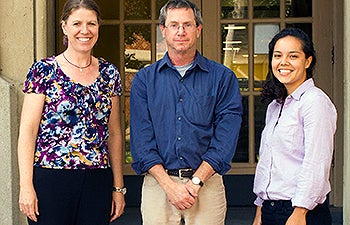Supporting Diversity in Science
As a first-generation college student pursuing a degree in geological sciences, Yadira Ibarra felt like the proverbial stranger in a strange land.
At Brown University, there were few women studying earth sciences. And even fewer who were Latina. It wasn’t until she presented her research at a Society for Advancement of Chicanos and Native Americans in Science (SACNAS) conference that she met many Latinas and Latinos studying science.
It felt like coming home.
“For the first time I was meeting peers who grew up in a similar environment as me,” said Ibarra, whose parents migrated from Mexico to Los Angeles. “I was amazed there were so many Latinos who wanted to become scientists.”
Now a geobiology doctoral student in USC Dornsife, Ibarra wants to bolster support for under-represented minority students in the fields of sciences, technology, engineering and mathematics (STEM). She has helped to create a SACNAS chapter on campus.
The chapter will start by providing a forum for Ph.D. students from underrepresented groups studying STEM fields to come together, hear about one another’s research and career trajectories, and find peer mentorship, said George Sanchez, USC Dornsife’s vice dean for diversity and strategic initiatives, who spearheaded the effort.
Chapter members will also reach out to underrepresented undergraduates to encourage them to consider Ph.D. work and careers in science. They will visit high schools and community colleges to speak to students about futures in science and technology.
“It’s important to note that SACNAS is open to all scientists, and is meant to promote diversity in all scientific fields,” Sanchez said. “It’s not only for Chicanos and Native Americans, but also promotes diversity for African Americans, women and first-generation college students — and all other groups that are underrepresented.”
For Ibarra, the 2008 SACNAS conference she attended as a Brown student also drew her to USC Dornsife. Ibarra attended a session led by William Berelson, professor of earth sciences in USC Dornsife.
“I was fascinated by the research he was doing,” Ibarra recalled. “It was similar to the research that I had been conducting as a major in biology and geology. I realized I could do research in a field that combined both of my interests.”
After hearing more about USC Dornsife’s geobiology program, Ibarra, who was born in Boyle Heights and grew up in East Los Angeles, decided to become a Trojan.

USC Dornsife’s William Berelson (middle) led a group that presented research during a SACNAS conference, where they recruited Yadira Ibarra (right), now a geobiology doctoral student and president of the SACNAS chapter on campus. Cindy Joseph of the Center for Dark Energy Biosphere Investigations on campus (left) also helped to create the USC SACNAS chapter. Photo by Woodrow Clark.
Berelson noted that former earth sciences doctoral student Everett Salas got his department fired up about attending the SACNAS conference, where they met Ibarra.
“For Everett to stand in front of his peers at the conference and explain how he is studying in this area, he opened eyes to the possibilities in the sciences,” Berelson said. “Because geobiology is a very new combination of fields, many don’t really understand what it is. But when these two sciences come together, the interface is where exciting things happen.”
Salas recalled that while an undergrad at Cal Poly Pomona, he switched his major five times, bouncing from business, to engineering and eventually to biology with plans to become a doctor.
“In the Mexican culture, you are expected to go to college,” he said. “But you’re expected to major in something that has practical value. If you’re going to go into science it’s because you’re going to go to medical school. You’re supposed to do something that pays, so you can help support your family.”
Once Salas finally followed his dream and became a student in USC Dornsife’s earth sciences doctoral program, he had to convince his parents he wouldn’t starve.
“I kept having to explain to my parents,” he said. “ ‘Science? What do you do with that?’ I didn’t have anyone to tell me that this is OK. This route is OK. That you can actually make a living being a scientist.”
To recruit and support minority students interested in the sciences, Salas began working with Sanchez to start a campus SACNAS chapter. Sanchez, Berelson, Ibarra and Cindy Joseph, who oversees the diversity program for National Science Foundation’s Center for Dark Energy Biosphere Investigations on campus, brought the effort to fruition.
“The SACNAS conference introduces students to researchers and National Science Foundation officers,” Joseph added. “The SACNAS chapter is a focus point for students on campus to recognize that resources are available to them. It’s a mechanism by which they can receive the help they need to conduct research.”
The number of minority students in USC Dornsife’s natural sciences Ph.D. programs has increased in the past five years. In Fall 2007, there were 16 underrepresented minority students in the natural sciences Ph.D. programs. Now there are 37 with 31 of those Latino.
“The numbers provide an upbeat story that leads directly to why there can now be a SACNAS chapter — there are enough students to support it and maintain it,” Sanchez said. “The chapter will greatly help in recruiting new students to these Ph.D. programs.”
For more information about USC Dornsife’s SACNAS group contact Yadira Ibarra, chapter president, at sacnas@usc.edu.